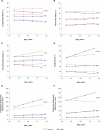Age- and sex-based reference limits and clinical correlates of myocardial strain and synchrony: the Framingham Heart Study
- PMID: 23917618
- PMCID: PMC3856433
- DOI: 10.1161/CIRCIMAGING.112.000627
Age- and sex-based reference limits and clinical correlates of myocardial strain and synchrony: the Framingham Heart Study
Abstract
Background: There is rapidly growing interest in applying measures of myocardial strain and synchrony in clinical investigations and in practice; data are limited regarding their reference ranges in healthy individuals.
Methods and results: We performed speckle-tracking-based echocardiographic measures of left ventricular myocardial strain and synchrony in healthy adults (n=739, mean age 63 years, 64% women) without cardiovascular disease. Reference values were estimated using quantile regression. Age- and sex-based upper (97.5th quantile) limits were: -14.4% to -17.1% (women) and -14.4 to -15.2% (men) for longitudinal strain; -22.3% to -24.7% (women) and -17.9% to -23.7% (men) for circumferential strain; 121 to 165 ms (women) and 143 to 230 ms (men) for longitudinal segmental synchrony (SD of regional time-to-peak strains); and 200 to 222 ms (women) and 216 to 303 ms (men) for transverse segmental synchrony. In multivariable analyses, women had ≈1.7% greater longitudinal strain, ≈2.2% greater transverse strain, and ≈3.2% greater circumferential strain (P<0.0001 for all) compared with men. Older age and higher diastolic blood pressure, even within the normal range, were associated with worse transverse segmental synchrony (P<0.001). Overall, covariates contributed to ≤12% of the variation in myocardial strain or synchrony in this healthy sample.
Conclusions: We estimated age- and sex-specific reference limits for measures of left ventricular strain and synchrony in a healthy community-based sample, wherein clinical covariates contributed to only a modest proportion of the variation. These data may facilitate the interpretation of left ventricular strain-based measures obtained in future clinical research and practice.
Keywords: echocardiography; left ventricular function; reference values.
Figures

References
-
- Shah AM, Solomon SD. Myocardial deformation imaging: Current status and future directions. Circulation. 2012;125:e244–248. - PubMed
-
- Mor-Avi V, Lang RM, Badano LP, Belohlavek M, Cardim NM, Derumeaux G, Galderisi M, Marwick T, Nagueh SF, Sengupta PP, Sicari R, Smiseth OA, Smulevitz B, Takeuchi M, Thomas JD, Vannan M, Voigt JU, Zamorano JL. Current and evolving echocardiographic techniques for the quantitative evaluation of cardiac mechanics: Ase/eae consensus statement on methodology and indications endorsed by the japanese society of echocardiography. Eur J Echocardiogr. 2011;12:167–205. - PubMed
-
- Mor-Avi V, Lang RM, Badano LP, Belohlavek M, Cardim NM, Derumeaux G, Galderisi M, Marwick T, Nagueh SF, Sengupta PP, Sicari R, Smiseth OA, Smulevitz B, Takeuchi M, Thomas JD, Vannan M, Voigt JU, Zamorano JL. Current and evolving echocardiographic techniques for the quantitative evaluation of cardiac mechanics: Ase/eae consensus statement on methodology and indications endorsed by the japanese society of echocardiography. J Am Soc Echocardiogr. 2011;24:277–313. - PubMed
-
- Zerhouni EA, Parish DM, Rogers WJ, Yang A, Shapiro EP. Human heart: Tagging with mr imaging--a method for noninvasive assessment of myocardial motion. Radiology. 1988;169:59–63. - PubMed
Publication types
MeSH terms
Grants and funding
LinkOut - more resources
Full Text Sources
Other Literature Sources

